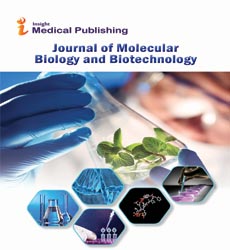A Short Note on Molecular Genetics
Yaping Liu*
Department of Genomics, University of Burundi, Bujumbura Burundi
- *Corresponding Author:
- Yaping Liu
Department of Genomics,
University of Burundi,
Bujumbura,
Burundi,
E-mail: yapingliu@redfill.com
Received Date: November 17, 2021; Accepted Date: December 01, 2021; Published Date: December 08, 2021
Citation: Liu Y (2021) A Short Note on Molecular Genetics. J Mol Biol Biotech Vol.6 No.S1:003.
Description
Atomic hereditary qualities are a sub-area of science that tends to how contrasts in the designs or articulation of DNA particles show as variety among creatures. Atomic hereditary qualities regularly apply an "insightful methodology" to decide the design and additionally capacity of qualities in an organic entity's genome utilizing hereditary screens. The field of review depends on the converging of a few sub-fields in science: traditional Mendelian legacy, cell science, sub-atomic science, natural chemistry, and biotechnology. Analysts look for changes in a quality or incite transformations in a quality to interface a quality arrangement to a particular aggregate. Sub-atomic hereditary qualities are an amazing approach for connecting transformations to hereditary conditions that might help the quest for medicines/remedies for different hereditary qualities illnesses.
The Central Dogma
The Central Dogma is the premise of all hereditary qualities and assumes a critical part in the investigation of sub-atomic hereditary qualities. The Central Dogma expresses that DNA duplicates itself, DNA is deciphered into RNA, and RNA is converted into proteins. Along with the Central Dogma, the hereditary code is utilized in seeing how RNA is converted into proteins. Replication of DNA and record from DNA to mRNA occurs in the mitochondria while interpretation from RNA to proteins happens in the ribosome. The hereditary code is made of four base sets: adenine, cytosine, uracil, and guanine and is excess significance various blends of these base sets (which are perused in three-fold) produce a similar amino acid. Proteomics and genomics are fields in science that emerge from the investigation of sub-atomic hereditary qualities and the Central Dogma.
Techniques
Forward genetics
Forward hereditary qualities are an atomic hereditary qualities method used to distinguish qualities or hereditary transformations that produce a specific aggregate. In a hereditary screen, arbitrary transformations are created with mutagens (synthetic substances or radiation) or transposons and people are evaluated for the particular aggregate. Frequently, an auxiliary test as a choice might follow mutagenesis where the ideal aggregate is hard to notice, for instance in microorganisms or cell societies. The cells might be changed utilizing a quality for anti-toxin obstruction or a fluorescent journalist so the freaks with the ideal aggregate are chosen from the non-mutants.
Freaks displaying the aggregate of interest are confined and a complementation test might be performed to decide whether the aggregate outcomes from more than one quality. The freak qualities are then portrayed as prevailing (bringing about an increase of capacity), passive (showing a deficiency of capacity), or epistatic (the freak quality covers the aggregate of another quality). At last, the area and explicit nature of the change is planned through sequencing. Forward hereditary qualities are a fair-minded methodology and frequently prompt numerous unexpected revelations, however might be exorbitant and tedious. Model creatures like the nematode worm Caenorhabditis elegans, the natural product fly Drosophila melanogaster, and the zebrafish, Danio rerio have been utilized effectively to concentrate on aggregates coming about because of quality mutations.
Reverse genetics
Switch hereditary qualities are the term for atomic hereditary qualities procedures used to decide the aggregate coming about because of a deliberate change in a quality of interest. The aggregate is utilized to find the capacity of the un-changed rendition of the quality. Transformations might be arbitrary or purposeful changes to the quality of interest. Transformations might be a mis sense change brought about by nucleotide replacement, a nucleotide expansion or cancellation to initiate a frame shift transformation, or a total expansion/erasure of a quality or quality section. The eradication of a particular quality makes a quality knockout where the quality isn’t communicated and a deficiency of capacity results (for example mice). Missense transformations might cause absolute loss of capacity or result in incomplete loss of capacity, known as a knockdown. Knockdown may in like manner be refined by RNA impedance (RNAi). Alternatively, qualities might be subbed into an organic entity's genome (otherwise called a transgene) to make a quality thump in and bring about an addition of capacity by the host. Although these methods have some inborn inclination in regards to the choice to interface an aggregate to a specific capacity, it is a lot quicker as far as creation than forward genetic characteristics considering the way that the nature of interest is at this point known.
Open Access Journals
- Aquaculture & Veterinary Science
- Chemistry & Chemical Sciences
- Clinical Sciences
- Engineering
- General Science
- Genetics & Molecular Biology
- Health Care & Nursing
- Immunology & Microbiology
- Materials Science
- Mathematics & Physics
- Medical Sciences
- Neurology & Psychiatry
- Oncology & Cancer Science
- Pharmaceutical Sciences
